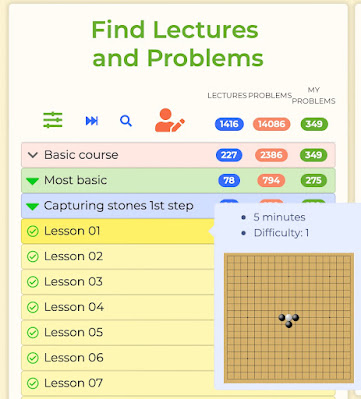This is a special blog post specifically for the Double Digit Kyu players of the BenKyo League, but it can serve as an introduction to the Internet Go School for anyone.
I would recommend Guo Juan's Internet Go School to all members of the BenKyo League, but I specifically want to mention its value to DDK players. I say this because Guo Juan has a collection of easy to understand beginner materials supported by a Spaced Repetition problem system that is perfect for not only beginners, but for any players still below 9 kyu.
The basics she covers are those that Ben Mantle could easily teach someone on a one-to-one basis over the course of a good deal of time. Or he could create a series of videos of his own covering the most basic of basics. However, this is a wheel that is clearly not worth his time to reinvent since this material already exists in a great format.
The vast collection of basic go knowledge on Guo Juan's website is available to you at a fairly low monthly subscription rate, and an even lower yearly subscription rate. Plus it is available for you to try for free for two weeks. If it isn't as great as I tell you it is, then simply cancel and you have lost nothing. If you want more subscribe by the month until you know you want to stay for good at which time you can switch to a yearly subscription which is considerably less expensive.
Spend a few months learning the basics on Guo Juan's site. Then decide if you want to stick around for more advanced knowledge. The Spaced Repetition System will probably keep you coming back for more.
The image at the top of the page is how the Internet Go School appears on my 13 inch MacBook Pro. The site is also available on your phone via your web browser. That is how I captured the "Try for Free" screen shot above.
I'll touch upon some of the sections of the site form the top image.
Below you can see some of the problem sets I have added from the Capturing stones 2nd step collection.
How to begin using the system?
Start with the Basic Course Materials. Even though the first set of lectures may be painfully simple they will familiarize you with the system and they will review the most basic information about go.
Watch it. You can slow down or speed up the replay if you desire.
Then click Add To Training System. This will place that set into your collection of problems. Problems will be presented to you each day. You decide how many problems you must complete each day. It can be as few as 10 or many more than that.
There is also a button to push called Quick Look that will allow you to view all of the problems associated with a lecture in sequence. You do not need to do this before adding the problems to your collection. You might want to come back to a set and review all of them all at one time once the problems have been integrated into the system, and scattered from each other. Quick Look can be good for that. Some people even like to use it as a preview of the material in the lecture.
Pressing the Home button will take you to a page that looks similar to the one I have at the top of the post. From there you can press Review or New to start doing problems.
The image above shows that I have completed all of problems that were due for the day and I earned an extra 50 points for doing so. You can see that I still have seven problems to review. This is because I have a few problems marked Not Yet which means that they will pop up again in a brief period of time until I mark them as "Got It". After that I can mark them as various levels of difficulty which will bring those problems back to me after periods of time ranging from hours to years. If you fail to answer a problem correctly after it has reappeared you can mark it as Forgot and begin again with it. This process is called Spaced Repetition and it brings problems to you frequently enough so you have a good chance of remembering the material, and if you don't, then you get to start over with that material until you do remember it. The easier the problems are for you the less frequently they appear. You do the evaluation of difficulty by marking it with buttons.
When you encounter a problem for the first time you will mark it as either Not Yet or as Got it. Until you get the problem it will pop up every ten minutes. Once you have gotten a problem you get a new set of buttons to evaluate the difficulty of the problem the next time you encounter it.
I have problems that aren't going to show up any sooner than ten years from now at this point. Here is one that wouldn't show up for 16 years if I marked it as easy.















No comments:
Post a Comment